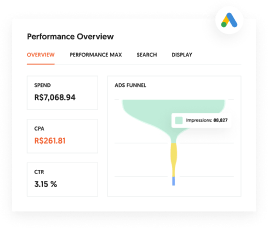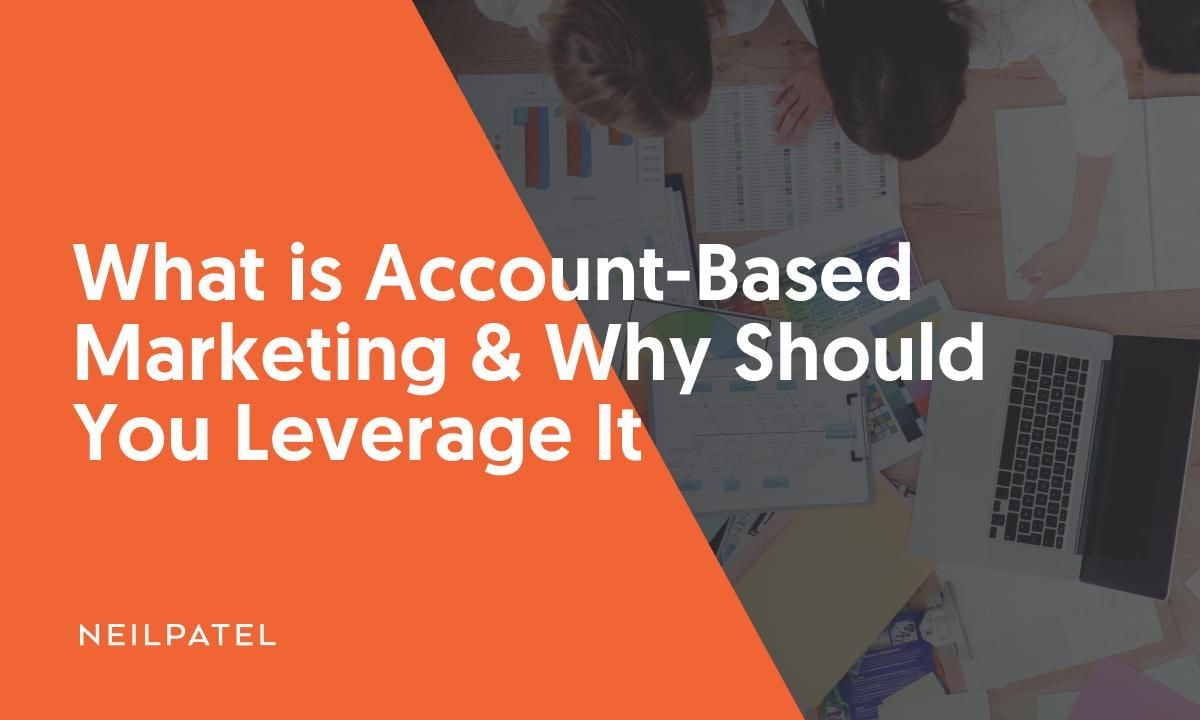
- The average email click-through rate is 2.6 percent.
- The average rate of return on direct mail is about 5 percent.
- A good social media campaign will convert at less than 1 percent.
Why are these numbers so low? Because many new marketing campaigns don’t have the right customer research, ideal client personas, personalization, or segmentation. They dangle a worm out there to see if anyone bites.
These factors are important, which is why account-based marketing (ABM) is a great opportunity. It is a great way to find the ideal client who will pay you month after month.
That’s the type of client you want, and that’s what we’re focusing on in this guide.
Key Takeaways About Account-Based Marketing
- Account-based marketing is a B2B marketing strategy that focuses on creating personalized buying experiences for high-value prospects.
- Examples of account-based marketing include webinars, live events, PPC, and email marketing.
- The benefits of ABM include bringing marketing and sales together, shortening the sales cycle, personalizing the process to save time and money, and measuring ROI more easily.
- Account-based marketing differs from traditional sales funnel marketing because it is more targeted, precise, and cost-effective.
What Is Account-Based Marketing (ABM)?
Account-based marketing is a B2B marketing strategy where the sales and marketing teams work together to find the most qualified accounts to become customers.
Instead of marketing to a large group of potential clients, ABM tailors marketing efforts to address the needs and interests of individual key accounts. It requires personalized communication and content creation that resonates with the specific challenges and goals of each targeted account.
Because your marketing efforts are so closely aligned with the needs of a particular target, ABM helps you build stronger, more meaningful relationships and increase the likelihood of successful conversions and long-term partnerships.
ABM is most beneficial for businesses with smaller, niche customer bases or high-value clients. If you’re seeking quality over quantity when it comes to customer interactions over a long sales cycle, an ABM strategy is your best bet.
Account-Based Marketing vs Traditional Sales Funnel
Account-based marketing flips the traditional sales funnel upside down.
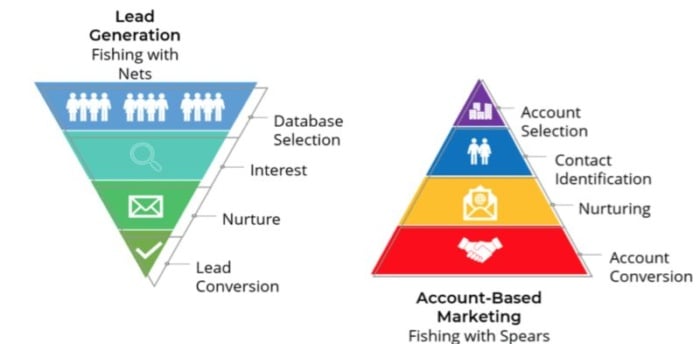
I love the example of fishing with nets versus fishing with spears.
When you fish with nets, you throw out a generalized marketing campaign to fit the needs of your customer persona, but you’re not entirely sure what will stick. You’re aiming to catch a larger audience and convert some of them into customers as you nurture them.
When you fish with spears, you pinpoint the clients you want with the help of your sales team. Working together helps the marketing team identify ideal clients and create a campaign that speaks directly to that audience.
This is how the two strategies compare to each other:
| Account-based Marketing (ABM) | Traditional Sales Funnel (TSF) |
| Accounts-based marketing helps businesses create personalized content and campaigns that resonate with the target audience, increasing engagement and conversions. | A traditional sales funnel, like inbound marketing, attracts a large pool of prospects and guides them through the various stages until they convert. |
| ABM requires a deep understanding of the customer’s needs, preferences, and behavior. | A TSF relies on more standardized messaging to appeal to a broader audience. |
| ABM focuses on building long-term relationships. | A TSF prioritizes a transactional approach. |
| The three main phases are identifying customers, engaging with them, and relationship building. | The three main phases of a TSF are awareness, consideration, and decision-making. |
Just because they differ, that doesn’t mean you can’t use them alongside each other.
By integrating ABM tactics into specific segments of the traditional funnel, organizations can enhance personalization and relationship-building where it matters most. This hybrid approach ensures that while the wider audience is engaged efficiently, high-priority accounts receive the personalized attention they require.
Examples of Account-Based Marketing
Account-based marketing works by creating campaigns for highly specific audiences. By going in with a particular target group in mind, you can customize campaigns like you never could before.
Here are some real-life examples of account-based marketing:
Webinars
Let’s say you’re targeting an audience that enjoys sea kayaking in Norway. That’s a pretty specific group, right? You can create a webinar marketing to kayakers looking to explore Norway by paddle—like the BCAB (British Canoeing Awarding Body) did last year:

Live Events
Even better than a webinar is a live, in-person event. Work with the sales team to identify key prospects as you plan this event. You can also create personalized upsells such as VIP passes, VIP rooms, or merchandise for the people you want to close. Here’s an example from Possible:

PPC
Google Ads, Facebook, LinkedIn, and Instagram are all ways to reach high-ticket clients through account-based marketing. Once you’ve identified your targets, you can create specific campaigns for those few prospects, just like GumGum did, to land T-Mobile as a client:
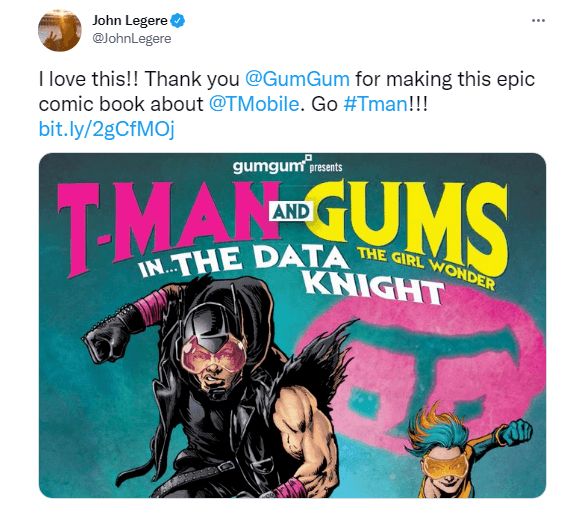
Remember the fishing with spears versus fishing with nets analogy?
With ABM, you’re no longer just throwing a net out to see if you catch anything. You know what you want to catch, where it is, and how to get it. You just have to do it.
Email marketing is another popular account-based marketing strategy for engaging and nurturing key accounts.
All you need to do is choose the accounts you’ll target, segment your email list, and create personalized content for each target account.
Sixty-five percent of marketers say that email is the most impactful use of personalization.
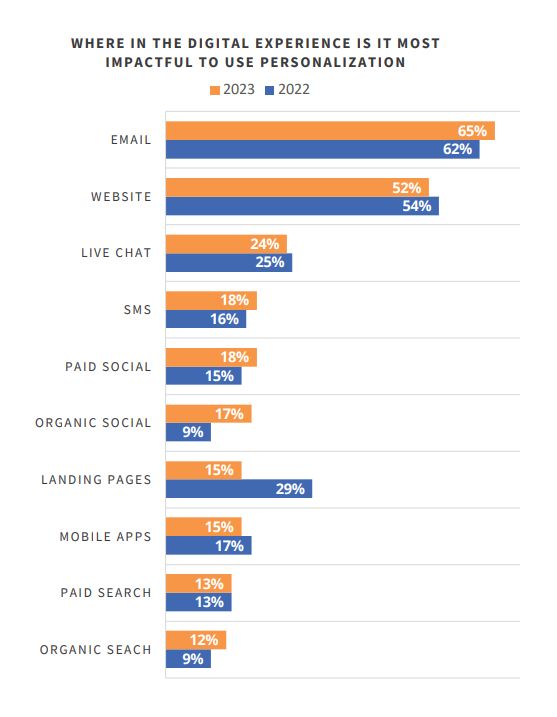
Effective email personalization goes beyond simply including a name in the subject line. To best execute email marketing in your ABM strategy, be sure to collect meaningful data about your target accounts and segment them based on business needs, pain points, and stakeholders.
Benefits of Account-Based Marketing
Why go through the trouble of developing an account-based marketing strategy versus something broader? There are a few benefits you should consider:
ABM Brings Marketing and Sales Together
One of the biggest issues many companies face is not having their sales and marketing teams on the same page. Account-based marketing allows these two departments to work together, understand a common goal, and help each other out.
ABM Enables A Shorter Sales Cycle
Shortening the sales cycle can save you so much time and money. This is one reason why an account-based marketing approach maximizes the ROI.
You can connect with key decision-makers early instead of using resources to engage with employees who may not have that authority. Because you are targeting decision-makers directly, you know they can pay, and you can serve them.
Personalization Through ABM Saves Time and Money
How often does your sales team spend their time speaking with prospects who barely understand what your business does? That’s a sign of broad marketing.
With account-based marketing, you attract prospects who are already warmed up, familiar with your company, and ready to make a decision. This type of personalized marketing saves time and money in the long run.
ABM Makes It Easier to Measure ROI
When narrowing down the funnel, we focus on fewer prospects. This makes it easier to figure out the ROI and deliver better results.
For instance, if we reach 100 ideal clients and convert 10, we know our account-based marketing conversion rate is 10 percent.
This sure beats reaching out to the entire East Coast with a marketing campaign and converting ten people—then having four duck out after their first month.
Instead, you’re nurturing long-term, well-qualified prospects that will stick with you.
Account-Based Marketing Tactics to Consider
Ready to dip your toes in account-based marketing? Here are some key tactics to enhance your ABM efforts:
- Identify High-Value Accounts: You’re looking for accounts with the best conversion potential. Look at revenues, product or service alignment, customer lifetime value, and average order values.
- Implement Personalized Content Creation: Write customized content that addresses the unique needs of your target accounts. In your marketing, highlight how your product/service addresses their pain points.
- Use Collaborative Sales and Marketing Alignment: Ensure your sales and marketing teams work together to implement strategies and achieve goals. Discuss feedback and data to refine your future account-based marketing strategy.
- Introduce Multi-Channel Engagement: Use targeted advertising through various channels, including email, social media, and paid adverts. Keep your messaging consistent across all platforms.
- Reach Out to Larger Audiences: Use webinars and conferences to attract target accounts. Tailor your content to their interests and use these events to demonstrate your expertise. For instance, if you are a cybersecurity company, you could use Q&A sessions to answer any questions prospects have.
How to Develop Your Account-Based Marketing Strategy
Now that you have an overview of account-based marketing let’s put it into practice with some actionable steps you can take.
1. Zero in on Your Targets
Work with your sales team to figure out some warm prospects. What characteristics describe them? What type of revenue do they have? What platforms do they live on?
Use all of this information to put together a personalized marketing campaign.
2. Research Them
Do plenty of research. Figure out what makes prospects tick and put together creative ideas that will make the prospect feel like the marketing campaign was made just for them—because it was.
3. Choose Your Channels
Where will you market to this audience? What are you going to use to do it?
Do they have a younger demographic on platforms like Instagram and TikTok? Are they older executives who prefer direct mail or live events?
These are some key questions you should ask before starting your campaign, especially if you expect to reach them and maximize your ROI.
4. Run Your Campaigns and Measure Frequently
When marketers run traditional PPC, social media ads, or any other type of campaign, they should gather enough data before making a conclusion. With account-based marketing, things are a little bit different.
You can spill your entire ad budget pretty quickly when you have a narrow audience. You want to check on these campaigns frequently to see if your approach is hitting or not. If you don’t see early success signs, adjusting accordingly is a good idea.
Tips for Implementing Account-Based Marketing
At this point, I’ve covered all the essentials for setting up your account-based marketing strategy. As you get rolling, keep these tips in mind to maximize your efforts:
- Plan Out Every Detail. You’re targeting a specific account, so precisely target your marketing campaigns.
- Align With the Sales Team. There should be no miscommunication on either side since everyone has the same goal of securing these high-ticket clients.
- Build a Dedicated Account-Based Team. They should focus on building relationships and understanding the needs of each account to streamline communications and limit the number of people you have to speak with before closing a sale.
- Have a Small Target. Don’t spread yourself out too much. Limiting your focus to two or three high-value accounts ensures your campaigns speak directly to their needs and pain points.
- Work With Decision-Makers Only. You’re pouring a lot of resources into these two or three accounts, so you can’t waste time. The key is to only deal with decision-makers in the company.
- Target Warm Prospects Only. In addition to reaching decision-makers, work with your sales team to find the warmest targets. These people know you and are interested in your product or service. You just haven’t converted them yet.
- Don’t Be Afraid to Adjust. Be sure to measure your results, change things as needed, and work with everyone involved to determine what you can do differently.
FAQs
An account-based marketing platform is a technology that allows you to scale your marketing campaigns. These platforms allow you to run larger campaigns at narrower audiences. Some examples include 6Sense, Demandbase, and Marketo.
Account-based marketing is important because it caters to a specific audience, which helps you maximize your ROI and bring in more high-ticket clients. This increases client retention over time and generally improves your company’s ROI.
Account-based marketing is used in various ways, but one of the most popular is to align marketing and sales teams. When these two departments work in perfect harmony, it helps bring in more high-value clients and shortens the sales process from beginning to end.
Conclusion
Account-based marketing is a smart choice for companies of all sizes, allowing you to create deeper relationships with clients who will be more meaningful to your bottom line.
Taking on this strategy will bring in the exact type of clients you need to keep retention rates up and build a strong base. Work with your sales to identify the right accounts, create your ideal buyer persona, and pick an avenue to reach that audience.
Have you ever implemented a successful account-based marketing strategy? Share your experiences below!

See How My Agency Can Drive More Traffic to Your Website
- SEO - unlock more SEO traffic. See real results.
- Content Marketing - our team creates epic content that will get shared, get links, and attract traffic.
- Paid Media - effective paid strategies with clear ROI.
Are You Using Google Ads? Try Our FREE Ads Grader!
Stop wasting money and unlock the hidden potential of your advertising.
- Discover the power of intentional advertising.
- Reach your ideal target audience.
- Maximize ad spend efficiency.

